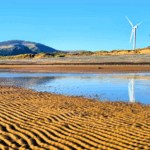The Nord Stream 2 pipeline has been in the news a lot in recent days, but what exactly is going on? Take a few minutes to get up to speed with the background to the recent controversy and what’s happening now.
What is Nord Stream 2?
Nord Stream is a system of pipelines to transport natural gas from Russia to Europe across the Baltic Sea. One pair of pipelines, Nord Stream 1, is already operational, with a capacity of 55 billion m3.
Construction of a second pair of pipelines, Nord Stream 2, began in 2018 with the intention of doubling Nord Stream’s total capacity to 110 billion m3. There is about 150km of Nord Stream 2 left to lay, with the unfinished section to be built in Danish and German waters.
Nord Stream 2 was supposed to become operational in mid-2020 and some estimates say that it is 97% finished, but now there are calls to halt the project even at this late stage.
Why build a second set of pipelines?
Natural gas production in Europe has been declining for years while the long-term trend is for demand to increase, so it makes sense for Europe to secure a reliable overseas supply and it makes sense for Russia to secure an export market for its plentiful reserves of natural gas.
The success of Nord Stream 1, currently the longest undersea pipeline in the world, has already proved that such a solution is technically possible and economically viable.
Why is its future in doubt?
Nord Stream 2 is owned and operated by a company called Nord Stream AG, which has its headquarters in Switzerland but is wholly owned by energy company Gazprom. Although Gazprom is a listed company, its main shareholder is the Russian state.
When Russian political activist Alexei Navalny was poisoned with the nerve agent Novichok, experts said the poison must have come from a state facility. German chancellor Angela Merkel was quick to condemn the Russian government and rumours began that Germany would withdraw from involvement with the Nord Stream 2 project. Norbert Röttgen, chair of the German parliament’s foreign affairs committee, said that Germany should rethink any gas deal with Russia and urged the EU to take strong action.
Meanwhile, the International Group of P&I Clubs, the world’s biggest group of shipping insurers, recently said that it will not insure any vessels involved in Nord Stream 2 – not because of the poisoning controversy but because of the threat of sanctions from the United States.
The US government has long been against the project because it threatens the European market for US liquefied natural gas (LNG). Many US politicians have claimed that it is bad for Europe too, most recently secretary of state Mike Pompeo, who said that it “endangers Europe because it makes it dependent on Russian gas”.
Will Angela Merkel pull the plug on Nord Stream 2?
If Nord Stream 2 is not completed, not only will Europe lose an important energy source but various European investors in the project, such as Royal Dutch Shell and E.ON, will lose out.
The German chancellor was asked in August if Germany should withdraw from Nord Stream 2 in response to the poisoning of Navalny. Her response was that they are two separate issues which should be “decoupled”.
A recent motion in the German federal parliament to stop the project was rejected by a large majority.
What will happen next?
It is possible that Nord Stream 2 could run into further trouble even if there are no objections from the German government. The threat of US sanctions is already having a chilling effect on businesses’ willingness to get involved with the project.
The reason that 150km of pipeline remains incomplete is that Swiss-Dutch energy company Allseas suspended work on it in December to avoid US sanctions.
There is also the possibility that Nord Stream 2 will fall foul of the EU’s regulations on the internal market for natural gas. In May this year, the project failed to secure an exemption to the competition rules that require separate ownership of gas and gas pipelines.
The German energy regulator ruled that the unfinished part of the pipeline to be built in German waters must have an owner/operator that is separate from the gas supplier. There may be legal ways round this, but it isn’t the only problem Nord Stream 2 has had with regulatory compliance. Gazprom was fined €50m last month because when Poland’s anti-monopoly regulator tried to check that Nord Stream 2’s financing was in compliance with the rules, Gazprom refused to cooperate with the investigation.
Other potential obstacles to the successful launch of the pipeline include various court cases launched by environmental groups against the project.
If Nord Stream 2 does go ahead, the effect will be to lower gas prices across Europe in the medium term. The production and transport costs of pipeline gas from Russia are significantly lower than the costs of importing LNG from the US (or other countries, such as Qatar). However, it is not certain how the end of the EU transition period will affect the UK energy market. The drastic fluctuations in energy demand brought about by COVID-19 are another reminder that this is a situation with many unknowns. The next few weeks and months could bring still more unexpected developments.




